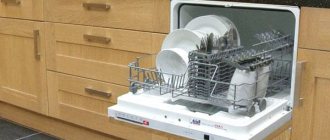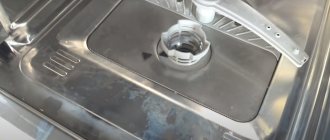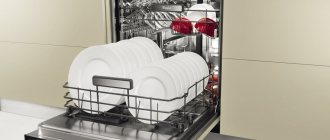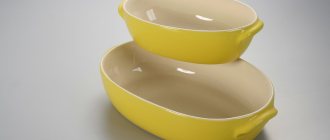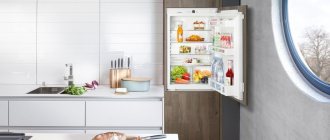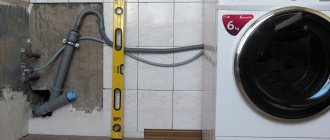The difference between installing a built-in dishwasher and a freestanding model is that additional design is required for the front wall - the machine door.
It is assumed that the decorative panel is selected to match the surrounding interior, and then the facade is installed on the dishwasher.
If experienced craftsmen cope with this operation quickly, then for beginners the task seems quite difficult. To understand the features of facade installation, you should carefully study the instructions and become familiar with some of the installation nuances. And we will tell you about all this in detail in our article.
Design features of built-in PMMs
The range of models integrated into kitchen units is much wider than their free-standing counterparts. This is explained by the principles of ergonomics and space saving inherent in the concept of constructing a kitchen interior. To get acquainted with the best brands specializing in the manufacture of built-in PMM models, please follow this link.
To install a built-in dishwasher, you will need a separate cabinet, or rather, a niche in the set. It differs from a regular kitchen cabinet in that it does not have a back wall or bottom.
The equipment is built inside furniture modules and decorated with facade panels so that when closed it is completely hidden. This installation method allows you to maintain the kitchen interior in the same style.
The machine is installed directly on the floor, on 3 or 4 support legs. The absence of a rear wall allows for free placement of the water supply and drain hoses.
The cabinet must have reliable walls to which the dishwasher body is attached, and a “roof” - the countertop. The front panel is not fixed to the walls, like conventional cabinets, but directly to the car door.
There is no need to experiment with fasteners : manufacturers have provided installation features and prepared special holes for self-tapping screws. We have provided detailed instructions for installing a built-in dishwasher model here.
What is a facade for PMM? This is a decorative panel, most often made of the same material as the front surface of the entire kitchen unit. It is made from MDF, plastic, laminated chipboard, solid wood or combined materials.
The fasteners are not visible from the outside, since installation is carried out from the inside, from the side of the machine door. Self-tapping screws are screwed into the holes and partially, not completely, enter the panel fabric
Where do you get decorative panels?
There are several ways to make it:
- ordered together with a kitchen set if the dimensions of the machine are known in advance;
- make it yourself from the doors of a disassembled kitchen cabinet;
- if there is no suitable “extra” facade, they are selected in a similar style and color design.
The first method is considered the most practical: when ordering, all dimensions of the car are taken into account, so the facade “fits” perfectly. But this method is not always applicable. We recommend that you familiarize yourself with the options for integrating a dishwasher into a finished kitchen.
Proper integration of the device into a furniture set at low prices
The dishwasher must be correctly installed in the furniture set in the apartment. Contact Yudu specialists who are engaged in these types of work. The craftsmen will quickly complete the task.
YouDo masters from Moscow will do the following work:
- will install equipment in a furniture set
- level the dishwasher in a niche using the legs
- install equipment using special fastenings
- connect the device to the necessary systems in the apartment kitchen
- they will hang furniture facades on equipment from Beko, Bosch, Electrolux, Siemens, etc.
The built-in dishwasher comes with special templates, which YouDo performers will use to attach the façade to the dishwasher. The fastening elements are installed in the grooves on the body of the household appliance and the decorative panel is installed.
Yudu performers offer the lowest prices for professional door installation. The price for installing furniture fronts on a built-in Bosch dishwasher and other appliances depends not only on the complexity of the work, but also on its urgency.
At what stage should the façade be attached?
The dishwasher is installed in several stages. The main connection is considered to be connection to communications: water supply, sewerage system, dedicated power line.
Decorating the front side is usually done at the very end, when the rest of the work has already been completed.
The housing is pulled out of the niche to provide access to the car door from all sides. But during the fitting process, it is better to push the machine into place so that the panels of the dishwasher and neighboring modules are at the same level
Is it possible to run the dishwasher without the decorative trim installed? It is not recommended to launch before installation work is completed for several reasons.
Only a dishwasher that is completely closed on all sides can fully perform its functions; in addition, the panel plays the role of an additional sound and heat insulator.
Sometimes they mask the machine first and then make the connection. This option is appropriate if there is a delay in connection for objective reasons, for example, at the same time the riser in the toilet is being replaced or a new power line is being laid.
In order not to waste time, decorate slowly.
Types of materials and decor of furniture facades for a dishwasher
Various materials are used to produce dishwasher fronts.
Basically it is MDF. Since it is he who is able to withstand temperature changes and high humidity that occur during operation of the equipment. In addition, they are safe and do not contain substances harmful to human health.
Natural wood is rarely used in the production of furniture for a built-in dishwasher, since it is a very expensive material that requires a high-quality top covering.
If you want to save money, you can purchase a facade made of chipboard - it will cost the least. But keep in mind that if the integrity of the protective layer is damaged, the product will quickly lose its shape. In addition, when heated, it will release toxic fumes.
To give the structure the desired color and texture, a decorative coating is used. Modern solutions make it possible to disguise a dishwasher in such a way that it will be impossible to understand that behind the façade there is hidden equipment and not an ordinary cabinet.
The facade for a built-in dishwasher can be finished with the following materials:
- enamel coating;
- plastic;
- glass;
- metal;
- veneer (thin layer of wood).
Preparation of tools and materials
No special tools are required to secure the façade trim.
The same items that are used to install the dishwasher as a whole will be useful:
- drill;
- screwdriver;
- awl;
- screwdriver;
- tape measure or ruler;
- pencil or marker.
If you don’t have a power tool, then one screwdriver is enough - you can screw in the screws by hand if the holes for them are pre-drilled.
The drill bit is selected according to the diameter of the screws: the holes should be a little tighter so that the fasteners are held firmly in the sockets
The work is simplified by the presence of a stencil for the façade overlay included in the delivery set. It is a large sheet of thin paper with marked attachment points.
The stencil is placed on the back side of the decorative panel and the places where the screws are screwed in are marked.
In addition to the tools, you will need double tape. Several “Velcro” pieces of tape will come in handy when you need to try on the facade. It is not recommended to immediately “mount” it on screws, since an error of 2-3 millimeters will mean all the work is in vain.
Don’t forget about the handle, without which opening the door will be problematic. It is also fixed with self-tapping screws, which are screwed into the back of the panel.
To ensure that the surfaces of the door and facade adjoin as tightly as possible, the heads of the screws should be recessed into the canvas.
It is easier to attach the workpiece than a homemade overlay. If you make the panel yourself, you may need carpentry tools, sandpaper for sanding, antiseptic impregnation and paint to finish the entire surface or just the ends.
How to calculate the width of the facade
In order for the product to look neat and attractive, the dimensions of the facade should be slightly larger than the dimensions of the equipment. But on sale there are panels of standard sizes with a width of 45 to 60 cm and a height of up to 82. Therefore, before you start purchasing, measure the unit you have at home, and, based on its parameters, choose the panels required in size.
Since the facade itself is an independent product, it will be almost impossible to adjust it at home, since the design feature and integrity of the decorative element will be compromised.
In order for the facade to fit evenly to the countertop, you will have to adjust the height of the dishwasher legs.
But what are the sizes of 45 cm built-in dishwashers and how they are installed is detailed here.
The dimensions of the facade will completely depend on the parameters of the cabinet, but here it is necessary to add a few centimeters for fastening to the cabinet doors.
And if the size of the machine is approximately 44.5 cm, then the side of the facade must be at least 46 cm.
The same approach should be used for equipment with a side of 60 cm - 1-2 cm more, so that it is convenient to open/close the doors for turning on and loading dishes into the equipment.
The video shows the calculations:
When decorating a kitchen, you should pay attention to what corner kitchen sets there are for a small kitchen.
Professional installation advice
To avoid the most common mistakes, we suggest using recommendations from experienced furniture makers:
- be sure to use a tape measure or ruler, do not use your eye, do not be lazy to check the even position of the template and the panel - the appearance of the kitchen facade as a whole depends on this;
- choose the correct length of the screws: they must fit confidently and deeply enough into the panel surface, without coming out from the front side and not deforming it;
- when using a paper template, be sure to secure it on all sides;
- you can use a regular screwdriver, but using a screwdriver speeds up the process;
- Attach the handle, focusing on the location of the handles on adjacent cabinets, try to maintain not only the position (parallel/perpendicular to the floor), but also the height;
- To prevent the PMM door from closing during installation work, place a couple of large books or another heavy object, such as an iron, on it.
If a former cabinet door is used as a dishwasher front, when trying it on, pay attention to the location of the old holes.
It is important to ensure that the old mounting holes do not come into contact with the new ones, otherwise the screws may pop out and the panel may partially come off.
After completion of all installation work, you can begin operating the equipment. But first, it is advisable to carefully study the rules of operation and maintenance of the dishwasher.
DIY façade installation instructions
Having chosen the right time and prepared the tools, you can begin installation. However, during the installation process they often encounter unpleasant nuances that can delay the installation of the facade indefinitely.
Let's consider installation features that are best taken into account before starting work.
Stage #1 - determine the dimensions of the decorative panel
To find out the exact dimensions of the facade panel, you do not need to make calculations or draw diagrams - the manufacturer did everything for us. The instructions indicate all the indicators of interest - length, width, thickness, allowances.
A variant of the diagram by which you can determine the dimensions of the decorative overlay. General drawings allow you to compare the dimensions of the machine and the cabinet in order to install the unit as level as possible
The width of the panel often matches the width of the dishwasher, since the door on the sides follows the parameters of the body. For example, for standard 60-centimeter models it is usually 598 mm, for 45-centimeter models – 448 mm (there are exceptions).
However, the height may vary. This depends on how the front of the adjacent kitchen cabinets is positioned.
The most practical option for a kitchen facade - a decorative plinth is stretched along the floor throughout the entire unit, covering the legs of furniture and appliances
It is allowed to use a panel a few mm longer than the recommended length if the interior requires it. The main thing is that the extra millimeters do not interfere with opening the door at a right angle.
If the overlay touches the base, then it is left unchanged, and the edge of the base is cut out along the contour of the facade.
Stage #2 - choose the right fixation method
It is prohibited to ignore the manufacturer’s recommendations and experiment with methods of attaching the lining. If you fix the facade in your own way, it may fall off or “move” to the side over time.
Traditionally, self-tapping screws are used to attach a decorative panel. They are good because, if necessary, they can be quickly unscrewed, and the cover can be removed and replaced.
If you use nails instead of self-tapping screws, you will definitely have problems with dismantling. Expensive appliances last for decades and can “outlive” your kitchen set.
To replace the trim with a panel from new furniture, you will have to rip out the nails with the risk of deforming the surface of the door.
It is a mistake to fix the façade with glue. Two extremes can occur: either the glue will quickly lose its properties due to temperature changes, or it will “tightly” fix the pad to the machine. Both options are impractical.
Leaving pieces of adhesive tape as fastenings is also frivolous - the panel will fall off under its own weight at the very first vibrations of the unit.
Stage #3 - perform the installation sequentially
Before you begin hanging the front, you need to check how level the dishwasher is installed relative to the adjacent cabinets and countertop. An inclined position may result in the panel being secured crookedly.
The second point concerns the sizes - you should check again whether the length and width of the overlay are accurately adjusted. If everything is good, you can start.
Work order:
If, when closing the PMM door, no large gaps or backlashes are formed, tighten the fasteners, and the work can be considered complete.
The rubber apron is an element of the installation kit. It performs a protective role, but some dishwasher owners ignore its installation. We recommend that you secure the apron in the designated place, according to the instructions.
After decorating the front side of the dishwasher, do not forget to make the side fastenings of the body.
To fix the side fastenings, you must first remove the upper basket for loading dishes, and then find the mounting holes and screw screws that are suitable in length from the side of the washing chamber into the side walls.
